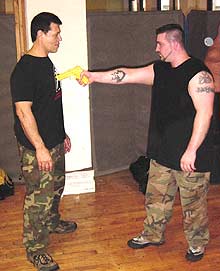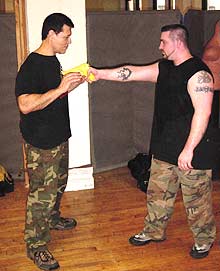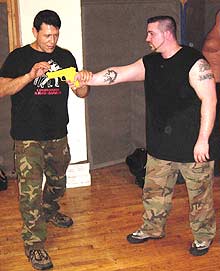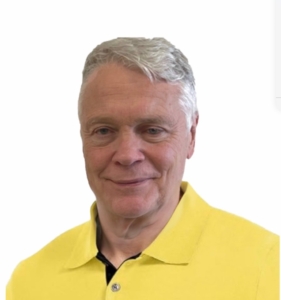When A Stickup Might Get You Killed:
The Universal Quick Pistol Disarm
By Christopher Caile
You never want to have to argue with a pistol, especially one pressed into you. If it is money they want, give it to them. Don't argue, don't fight. But if you are convinced that your life is at stake, that the gunman will shoot you no matter what, you just might want to know this technique.
This technique is demonstrated by Moni Aizik, founder and chief instructor of Combat Survival Commando Krav Maga, who was recently in New York City for a training seminar. He graciously extended me an invitation. Mori teaches hand-to-hand combat and weapons training using simple straight forward and effective technique that evolved from first generation Krav Maga and other fighting arts.
The benefit of this technique is that it is fast, simple and, effective. (1) It will work against a whole variety of gun positions, right hand or left, to the chest, head, side of the head, back of the head, to the side of the body or to the upper back – if the gun barrel is actually pressed into the defender, or is at least nearly touching. Thus, the beauty of this disarm is that you only have to learn one technique moving the hands and body the same way.




The sequence of photos above moves from left to right. A robber with a gun in his right hand extends his arm pressing the pistol into the chest of the defender. In reality the gun arm can be straight or bent. The defender immediately raises his arms, keeping them in front his body and at the level of the gun – and as near to the gun as possible. Moving the hands up or outside the body adds both difficulty and time to any defense. The defender should look defensive, compliant, even scared. Don't look in the attacker's eyes since the attacker may pick up any movement before it actually begins. Say something like, "OK, OK, what you want?", or "I don't want any trouble, what you want." Here the idea is to sell the gunman that he has been successful. This will dispel some of his own fear and tension and allow him to say to himself something like, "I've got this sucker." If you are going to disarm, be sure to first to also add some other words, something he will have to mentally process and answer – the processing itself working to slow the reaction time to any move you make. Some people here suggest that the words have no simple meaning, something confusing – the effect requiring more mental processing time from the gunman, something like, "My money and wallet ontology." When he starts to speak, such as asking you to repeat what you said, or asking what you meant, move. This is the point of the attacker's slowest reaction time.
The third photo shows the first move of the disarm. Moni's left hand moves a few inches inside grabbing the wrist of the gun hand while his body pivots to the right (moving him off line of any gun shot). At the same time Mori's right hand has shifted to just above and outside of the gun barrel in order to grab it from the top. The idea is to get hold of the lower forearm and gun barrel thus exposing the wrist to a quick technique that will dislodge the gun. This very same technique using the same hands would be executed in just the same way if the attacker is holding the gun in his other hand.

It is important to remember that you are dealing with a gun. Often a person trained in hand-to-hand combat will try to add an extra percussion technique, an elbow, punch or knee. While this might work, an extra move might just give the attacker that instant an respond and he may grab you back. The last place you ever want to be is caught fighting over control of a gun.
 Instead, what you want to do is to disengage as quickly as possible. This means not only stepping back, but retreating as quickly as possible while pointing the gun on the opponent. Of course you could just run, but the environment or circumstance may dictate that you momentarily orient yourself. In any case, safety here means distance – ten feet or more. Your attacker might just try to fight back, rush you or have a back-up knife. So about the time the momentary shock wears off that he has lost his gun, you should be heading for the hills. Also, make it clear that you will shoot if he advances.
Instead, what you want to do is to disengage as quickly as possible. This means not only stepping back, but retreating as quickly as possible while pointing the gun on the opponent. Of course you could just run, but the environment or circumstance may dictate that you momentarily orient yourself. In any case, safety here means distance – ten feet or more. Your attacker might just try to fight back, rush you or have a back-up knife. So about the time the momentary shock wears off that he has lost his gun, you should be heading for the hills. Also, make it clear that you will shoot if he advances.
A note of caution: If the defender uses the technique as shown (grabbing the wrist with the left hand and the gun barrel with the right) against an attacker holding the gun in the left hand, the disarm will catch the gunman's finger in such a way that the disarm will break or severely injure the finger involved. So if practicing this disarm, either use a practice gun without a finger guard, or if the practice weapon has a finger guard, the person simulating the attack should leave his or her finger outside the guard.
The only limitation of this disarm technique is if the gunman holds the gun very low, such as pressed into the belly at belt height or lower, a location below which the defender's raised hands (even if held low) can easily move to grasp the arm or gun. Defenses for these positions will be covered in future articles.
Editor's Note: This article is posted solely for educational purposes. FightingArts.com and Moni Aizik never advise that this technique be attempted on the street or elsewhere unless the defender has been fully trained over extended time by a professional teacher and even then not used against a gunman who intends only robbery. This article alone is not sufficient training, for circumstances and positioning interject many variables that can not be sufficiently covered in an article of this length. In addition, considerable practice is required to master this technique, practice that should be supervised under qualified and professional hands-on guidance.
It should also be noted that the term, "Universal Quick Pistol Disarm," is one not necessarily used by Mori Aizik, but was used by the author to simply categorize this technique.
Footnote:
(1) There are many different methods of weapon disarm. I am well acquainted with the one demonstrated in this article since it is also taught by W.R. Man in his New York Based Real Fighting (see: www.RealFighting.com). It is simpler and more direct than the ones which are often taught in aikido and many jujutsu systems where a raised hand and forearm sweeps inside and captures the wrist or lower forearm (the arm on the same side of the hand holding the weapon), accompanied by a body shift to get outside the opponent and off the line of fire, then a short lead followed by a reversal of direction accompanied by a wrist technique used as a take away.
About Moni Aizik
Moni started his martial arts training in Judo and Jiu Jitsu at the age of 8. In his youth, Moni dominated Israel's tournament scene winning 7 national titles. During his late teens, Moni joined the Israeli military and became a member of an elite commando unit known as the Sayret.
During the Yom Kippur War in 1973, Moni was involved in special commando missions behind enemy lines. During one of these missions, his unit of 64 members was ambushed by over 1,000 Syrian soldiers in the Golan Heights. Only 6 of the members managed to survive and escape, primarily because of their superior hand-to-hand combat skills. Shortly after, Moni was assigned to develop a more comprehensive and improved version of Krav Maga to the Israeli Military.
Paired with Imi Lichtenfeld, the founder of Krav Maga, the two collaborated on developing a more definitive system of Krav Maga. By combining elements of Krav Maga, Judo and Jiu Jitsu, along with real combat experience, Moni created Commando Krav Maga, the militarized style of Krav Maga. From his experiences in the battlefield, Moni had a deep understanding of what techniques would and wouldn't work in a real life or death situations and integrated CKM with Israeli Special Forces training.
Moni later started teaching his system to the public, opening a school in Israel and eventually in Canada. He now teaches this technique modified toward street self-defense needs. His technique focuses on quick, explosive tactics that deliver maximum impact.
Other of Moni's students have also found success in competition. Some of Moni's past students include Yael Arad (Olympic Silver in Judo) and Carlos Newton (former UFC Champion).
Moni is currently teaching CKM to military, law enforcement and security units around the world. As well, Moni has a school based in Concord, Ontario that is open to the civilian sector. For more about Moni Aizik: http://www.combatsurvival.com/

About the Author Christopher Caile

Screenshot
Christopher Caile is the Founder and Editor-In-Chief of FightingArts.com. He has been a student of the martial arts for over 65 years.
He first started in judo while in college. Then he added karate as a student of Phil Koeppel in 1959 studying Kempo and Wado-Ryu karate. He later added Shotokan Karate where he was promoted to brown belt and taught beginner classes. In 1960 while living in Finland, Caile introduced karate to that country and placed fourth in that nation's first national judo tournament.
Wanting to further his karate studies, Caile then hitch hiked from Finland to Japan traveling through Scandinavia, Europe, North Africa, the Middle East and South and Southeast Asia — living on 25 cents a day and often sleeping outside.
Arriving in Japan (1962), Caile was introduced to Mas Oyama and his fledgling full contact Kyokushinkai Karate by Donn Draeger, the famous martial artist and historian. Donn also housed him with several other senior international judo practitioners. Donn became Caile's martial arts mentor, coaching him in judo and introducing him to Shinto Muso-ryu under Takaji Shimizu.
Caile studied at Oyama's honbu dojo and also at Kenji Kurosaki's second Tokyo Kyokushinkai dojo. In his first day in class Oyama asked Caile to teach English to his chief instructor, Tadashi Nakamura. They have been friends ever since. Caile also participated in Oyama's masterwork book, "This Is Karate."
Caile left Japan with his black belt and designation as Branch Chief, the first in the US to have had extensive training in Japan directly under Oyama Sensei. As such, Oyama Sensei asked him to be his representative on visits to his US dojos to report on their status.
A little over a year later, Nakamura, Kusosaki and Akio Fujihira won an epic David vs. Goliath challenge match against Thailand's professional Muay Thai Boxers in Bangkok, Thailand, thrusting Kyolushinkai and Nakamura into national prominence.
Back in the US Caile taught Kyokushinkai karate in Peoria, Il while in college and later in Washington, DC. while in graduate school. Durimg this time Shihan Nakamura had moved to New York City to head Kyokushinkai's North American Operation.
In 1976 when Kaicho Tadashi Nakamura formed the World Seido Karate organization, Caile followed. Living then in Buffalo, NY, Caile taught Seido karate and self-defense at the State University of New York at Buffalo (SUNY Buffalo) for over 15 years where he also frequently lectured on martial arts and Zen in courses on Japanese culture.
Caile moved to New York City in 1999 to marry Jackie Veit. He is now an 8th degree black belt, Hanshi, training in Seido Karate's Westchester, NY Johshin Honzan (Spiritual Center) dojo. In Seido Caile is known for his teaching of and seminars on kata applications. He also produced a 14 segment video series on Pinan kata Bunkai currently available to Seido members.
Caile is also a long-time student and Shihan in Aikido. He studied in Buffalo, under Mike Hawley Shihan, and then under Wadokai Aikido's founder, the late Roy Suenaka (uchi deshi under Morihei Ueshiba, founder of Aikido and was Shihan under Tohei Sensei). In karate, Suenaka (8thdan) was also an in-house student of the Okinawan karate master Hohan Soken.
Having moved to New York City, Caile in 2000 founded this martial arts educational website, FightingArts.com. Twenty-five years later, in 2025, it underwent a major update and revision.
For FightingArts.com and other publications Caile wrote hundreds of articles on karate, martial arts, Japanese art, Chinese Medicine and edited a book on Zen. He also developed relationships with a cross section of leading martial arts teachers. Over the last four decades he has conducted extensive private research into karate and martial arts including private translations of the once secret Okinawan hand copied and passed on Kung Fu book, the Bubishi, as well as an early karate book by the karate master Kenwa Mabuni. He periodically returns to Japan and Okinawa to continue his studies and participate Seido karate events. In Tokyo he practiced (with Roy Suenaka Sensei) in a variety of aikido organizations with their founders – including private interviews and practices at the Aiki-kai Aikido Honbu dojo with the son and grandson of aikido's founder, Doshu (headmaster) Kisshomaru (an old uchi-deshi friend) and his son, Moriteru Ueshiba and in Iwama with Morihiro Saito. On Okinawa he studied Goju Ryu karate under Eiichi Miyazato, 10th dan founder of Naha's Jundokan, and also with Yoshitaka Taira (who later formed his own organization, who specialized in kata Bunkai. While there Caile also trained with Hohan Soken's senior student, Master Fusei Kise, 10 dan as well as with the grandson of the legendary karate master Anko Itosu.
Caile's other martial arts experience includes: Diato-ryu Aikijujitsu and Kenjitsu, kobudo, boxing, Muay Thai, MMA, Kali (empty hand, knife and bolo), study of old Okinawan Shoran-ryu & Tomari body mechanics, study of old Okinawan kata under Richard Kim, study of close quarter defense and combat, including knife and gun defenses, Kyusho Jitsu and several Chinese fighting arts including 8 Star Praying Mantis, Pak Mei (White Eyebrow), and a private family system of Kung Fu.
Caile is also a student of Zen as well as a long-term student of one branch of Traditional Chinese Medicine, Chi Kung (Qigong). As one of two senior disciples of Chi Kung master Dr. Shen (M.D., Ph.D.) Caile was certified to teach and practice. This led to Caile's founding of the The Chi Kung Healing Institute on Grand Island, NY. In Western NY, he also frequently held Chi Kung seminars, including at SUNY Buffalo and at the famous Chautauqua Institution in Chautauqua, NY. His articles on Chi Kung also appeared in the Holistic Health Journal and in several books on alternative medicine.
Caile holds a BA in International Studies from Bradley University and MA in International Relations with a specialty in South and Southeast Asia from American University in Washington, D.C. While in Buffalo, NY he also studied digital and analog electronics.
In his professional life Caile also worked in public relations and as a newspaper reporter and photographer. Earlier he worked in the field of telecommunications including Managing a Buffalo, NY sales and service branch for ITT. He then founded his own private telephone company. This was followed by creation of an electrical engineering company that designed and patented his concept for a new type of low-cost small business telephone system (which was eventually sold to Bell South). The company also did contract work for Kodak and the US space program. Simultaneously Caile designed and manufactured a unique break-apart portable pontoon boat.
Most recently Caile co-founded an internet software company. Its products include software suites with AI capability for control and management of streaming media, such as video and music, an all-in-one book publishing software product for hardcover, eBook and audio book creation and security software for buildings and government use.
For more details about Christopher Caile's martial arts, work experience and life profile, see the About section in the footer of this site.
Search for more articles by this author:






